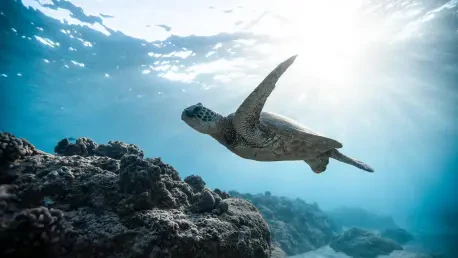In the heart of the Arabian Gulf, Qatar stands as a remarkable champion for sea turtle conservation, particularly for the critically endangered Hawksbill Sea Turtle, a species integral to the health of marine ecosystems. This small yet ambitious nation has taken on the daunting task of protecting these ancient creatures from a barrage of environmental threats, including climate change, pollution, and human interference along its coastal regions. With a strategic blend of scientific innovation, robust policy frameworks, and active community involvement, Qatar is not just addressing local challenges but also setting a powerful example for global conservation efforts. The urgency of safeguarding sea turtles is clear, as their survival directly influences the balance of marine biodiversity. Through the dedicated work of the Ministry of Environment and Climate Change (MECC), Qatar is forging a path that prioritizes ecological sustainability, ensuring that these vital species continue to thrive in the face of mounting adversities.
Qatar’s Strategic Conservation Initiatives
Building a National Framework
Qatar’s commitment to sea turtle preservation is deeply embedded in its national strategy, with the Sea Turtle Protection Project, initiated in 2003, serving as a cornerstone for protecting the Hawksbill Sea Turtle. This initiative focuses on critical nesting sites along the northern coasts and islands, employing a range of protective measures. Nest relocation is a key tactic, moving eggs away from the dangers of high tides and extreme temperatures to safer, monitored locations. Additionally, satellite tracking provides valuable data on migration patterns, while temperature monitoring ensures optimal hatching conditions. Seasonal beach closures during nesting months further shield these vulnerable areas from human disturbance. Led by the MECC’s Wildlife Development Department, this comprehensive approach underscores a dedication to preserving biodiversity through scientifically grounded methods, ensuring that each intervention is tailored to the specific needs of sea turtles in Qatar’s unique coastal environment.
Beyond the immediate protective actions, Qatar’s framework extends to long-term sustainability goals that integrate conservation with national development priorities. The emphasis on protecting endangered species like the Hawksbill is not merely about survival but about maintaining a natural heritage for future generations. Policies enforced by the MECC include strict regulations against activities that could harm nesting sites, alongside continuous monitoring to assess population trends. These efforts are supported by public awareness campaigns that educate citizens and visitors about the importance of minimizing impact on coastal habitats. By embedding sea turtle conservation into broader environmental policies, Qatar ensures that economic growth does not come at the expense of ecological balance. This holistic strategy demonstrates a forward-thinking mindset, where every measure—from nest protection to policy enforcement—contributes to a larger vision of environmental stewardship in the region.
Collaboration and Research Efforts
Qatar’s conservation initiatives are significantly strengthened through strategic partnerships with academic institutions like Qatar University and industrial giants such as QatarEnergy, fostering a robust research ecosystem. These collaborations drive critical studies into the genetic diversity of sea turtle populations, helping to understand their resilience and adaptability. Research also delves into the impacts of climate change, such as rising sea temperatures and coastal erosion, which directly affect hatching success rates. By leveraging cutting-edge technology and data analysis, these partnerships ensure that conservation strategies remain dynamic and responsive to emerging challenges. The synergy between academic rigor and industrial support not only enhances the scientific foundation of Qatar’s efforts but also positions the nation as a leader in marine research within the Gulf region, setting a benchmark for evidence-based environmental protection.
Moreover, the focus on research extends to practical applications that directly benefit sea turtle populations through innovative monitoring techniques. Satellite tracking, for instance, provides real-time insights into migration routes, identifying critical habitats that need protection. DNA sampling helps in mapping genetic lineages, offering clues about population health and diversity. These scientific endeavors are complemented by environmental impact assessments conducted in collaboration with industrial partners, ensuring that development projects near coastal areas minimize disruption to turtle habitats. This integration of research with on-ground action reflects Qatar’s commitment to a data-driven approach, where every finding contributes to refining conservation tactics. Such efforts highlight how scientific inquiry and practical implementation can work hand in hand to address the complex challenges facing marine biodiversity in a rapidly changing world.
Community and Regional Engagement
Fostering Local Involvement
A pivotal element of Qatar’s success in sea turtle conservation lies in its ability to engage local communities, creating a shared sense of responsibility for marine protection. Volunteers, students, and residents actively participate in hands-on initiatives such as beach clean-ups, which remove harmful debris like plastic waste that threatens turtle nesting sites. Nest monitoring programs allow community members to observe and protect eggs during critical hatching periods, while hatchling release events offer a tangible connection to the conservation process. These activities, often organized by the MECC, cultivate an environmental ethic among participants, reinforcing the idea that protecting sea turtles is a collective duty. By involving diverse segments of society, Qatar ensures that conservation is not just a governmental mandate but a cultural value deeply ingrained in the national consciousness.
Equally important is the educational outreach that accompanies community involvement, aiming to build long-lasting awareness about marine conservation. Schools and local organizations frequently host workshops and events that teach the ecological significance of sea turtles, emphasizing their role in maintaining healthy coral reefs and seagrass beds. Public campaigns encourage behaviors such as reducing plastic use and respecting restricted beach areas during nesting seasons. These efforts are amplified through accessible reporting mechanisms, like the MECC hotline, where citizens can report sightings or disturbances, ensuring rapid response to potential threats. This grassroots engagement transforms conservation into a community-driven movement, where every individual action contributes to the broader goal of safeguarding Qatar’s marine heritage against the myriad challenges posed by modern environmental pressures.
Strengthening Gulf Cooperation
Qatar’s vision for sea turtle conservation transcends national borders, evident in its collaborative efforts with other Gulf countries to enhance regional marine biodiversity. By sharing data on turtle migration patterns through joint tracking programs, Qatar contributes to a comprehensive understanding of how these species move across the Arabian Gulf. This cooperation facilitates the creation of shared databases that map critical habitats and identify transboundary threats, fostering a unified approach to protection. Such partnerships underscore the recognition that marine conservation requires collective action, as sea turtles do not adhere to political boundaries. Through these regional alliances, Qatar plays a pivotal role in harmonizing conservation strategies, ensuring that efforts in one nation complement those in another for maximum impact on species survival.
In addition to technical collaboration, Qatar prioritizes educational and public engagement initiatives that resonate across the Gulf region, amplifying the conservation message. Regional workshops and awareness events bring together experts and communities from neighboring countries to exchange knowledge and best practices. These gatherings often highlight the cultural significance of sea turtles, framing them as a shared heritage that binds the Gulf nations. Public reporting systems, accessible to residents and visitors alike, encourage cross-border participation in monitoring and protecting turtle populations. By fostering this spirit of regional solidarity, Qatar not only strengthens its own conservation framework but also inspires a broader movement for marine protection. This collaborative ethos ensures that past efforts have laid a strong foundation, reflecting a commitment to sustained progress in safeguarding the Arabian Gulf’s ecological treasures for future generations.









